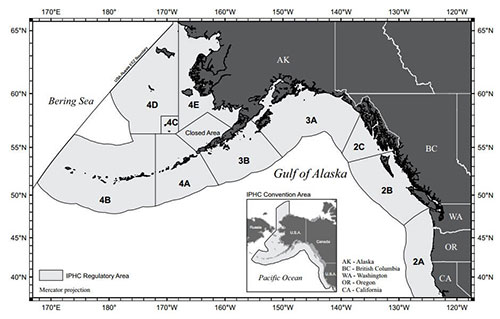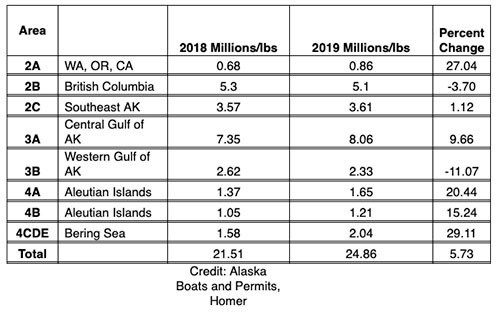|
Fish Factor 2019 Commercial Catches of Pacific Halibut IncreasedBy LAINE WELCH
February 04, 2019
The numbers were revealed Friday at the International Pacific Halibut Commission annual meeting in Victoria, British Columbia.
The reason was due to increased estimates of the overall halibut biomass based on expanded surveys last summer from Northern California to the Bering Sea, said Doug Bowen who operates Alaska Boats and Permits in Homer. “There’s a couple of strong year classes from 2011 and 2012 that are just starting to show up in the commercial catches and I think the scientists are cautiously optimistic that we could see some better harvests as a result of those halibut entering the fishery,” he said in a phone call as he was leaving the meetings. The coastwide commercial catches were increased to nearly 25 million pounds, almost six percent higher than 2018. Alaska’s share will be just under 20 million pounds, a boost of about three million pounds. Southeast Alaska’s catch was upped by just over 1 percent to 3.6 million pounds; the Central Gulf gets a nearly 10 percent increase to over 8 million pounds. The Western Gulf is the only Alaska region to get a halibut reduction – a catch of 2.3 million pounds is a drop of more than 11 percent. Halibut harvests at the two Aleutian Islands regions were increased to well over one million pounds and the Bering Sea catches went up by nearly 30 percent to top 2 million pounds. Bowen said the increases came despite concerns by IPHC executive director, Dr. David Wilson. “He feels that any coastwide catches over 20 million pounds will result in declines in the biomass. So, it is interesting that the catch limits are going up in light of the fact that we do have both declining recruitment and harvest rates coastwide,” Bowen said. The halibut fishery will open on March 15 and run through November 14, said Martin Milne, president of the Kenai Peninsula Fishermen’s Association. And in more good news for Alaska, Milne added that next year’s IPHC annual meeting will be held in Anchorage.
Deckhands wanted: The call is out for Alaskans interested in learning firsthand about commercial fishing.
It’s the second year for the Crewmember Apprenticeship program hosted by the Alaska Longline Fishermen’s Association in Sitka. Over 100 applied last year from all over the country, over half were women, and 13 were placed on local boats. “It’s very exciting to see so many young people interested in entering the industry,” said Tara Racine, ALFA communications and program development coordinator. “You always hear about the graying of the fleet but it shows that the interest is out there. Young people just need these resources to explore and get involved.” ALFA received a $70,000 matching grant from the National Fish and Wildlife Foundation to launch the program last year and to help support expansion of similar apprenticeships in Alaska. “We are hoping to share any information and lessons that we’ve learned and materials we’ve created from this program and give it to anyone interested in doing a program like this,” Racine said. Most of the recruits last year went out on longline and troll vessels and plans include expanding to seiners and gillnetters in a flexible fishing schedule. “We have short and long term programs,” she explained. “It could be just a couple of days for people who just want an introduction to fishing. We also have plenty of individuals who go out for the entire season or several weeks at a time.” The rookies are paid for their work and Racine said skippers are eager to show them the ropes. “The skippers that are interested are looking for reliable crew and want to mentor the next generation of resource stewards and skilled fishermen,” she said. “So not only are they training a pool of young people as deck hands, they also are ensuring the life of this industry that they love and is so important to our coastal communities.” Longtime salmon troller Eric Jordan has mentored over 40 young fishermen aboard his vessel, the I Gotta. Out on the water, he teaches them the intricacies of commercial trolling and encourages a strong conservation ethic. He calls the apprenticeship program “a win-win for the crewmembers and the skippers.” “The future of our fisheries is dependent on young fishermen learning to love and care for the fish we harvest and the habitat essential to their well-being,” said Jordan. “Finding crew with some experience is critical for individual businesses and the industry as a whole. Our generation’s legacy will be defined how we, as Alaskan fishermen, rebuilt and enhanced our fisheries, and how we mentored the next generation.” Applicants must be 18 or older to apply and the deadline is February 28. Sign on at www.alfafish.org/apprenticeship/ Fish farm fans: The push for industrialized offshore fish farms is gaining steam among American lawmakers. Farming fish is banned in Alaska waters, but the Trump Administration proposes to put net pens in federal waters, meaning from three to 200 miles out. The farms are being touted as a silver bullet to boost seafood production, provide jobs and reduce the nation’s $15 billion seafood trade deficit from importing over 85 percent of its seafood. Since last June a coalition called Stronger America Through Seafood (SATS) has swelled from 14 to 21 large companies, including Cargill, Red Lobster, Sysco, Pacific Seafoods and Seattle Fish Company. Currently there is only one offshore farm operating in U.S. waters - a mussel farm called Catalina Sea Ranch six miles off the coast of Los Angeles, California. At a U.S. Commerce Department hearing in Juneau last September, spokesperson Margaret Henderson said that Alaska’s stance is a sticking point. “We in no way mean to impede a state’s authority to manage their own waters, but when it comes to managing federal waters outside the state line, we think that there’s a balance to be had there, that there’s room for both,” she said. Undercurrent News reported last week that SATS has begun collecting signatures to support legislation to streamline the permitting process for offshore fish farms and plans to submit its petition to Congress on February 6. An earlier effort failed, but the Advancing the Quality and Understanding of American Aquaculture (AQUAA) Act will be reintroduced soon in the U.S. House and Senate by lawmakers from Mississippi, Florida and Minnesota. At the Alaska hearing, Under Secretary of Commerce Timothy Gallaudet cited climate change in his pitch for the push. “Changes in the environment are affecting fish stocks,” he said. “They are either moving or they’re not thriving and so this aquaculture, done the right way and scientifically based, provides a means for employment of fishermen who are losing some of their gain through these changing conditions.” A group of about 140 small scale fishermen and fishing groups has formed to fight the effort. At the Juneau hearing, Sam Rabung, new director of Alaska’s commercial fisheries division, also spoke out against offshore fish farms. “I think it’s safe to say that we’re going to fight pretty hard to maintain the state’s opt-out option and maintain the ability to prohibit finfish farming off of Alaska.”
SitNews ©2019 Stories In The News Ketchikan, Alaska
|
||||||||






